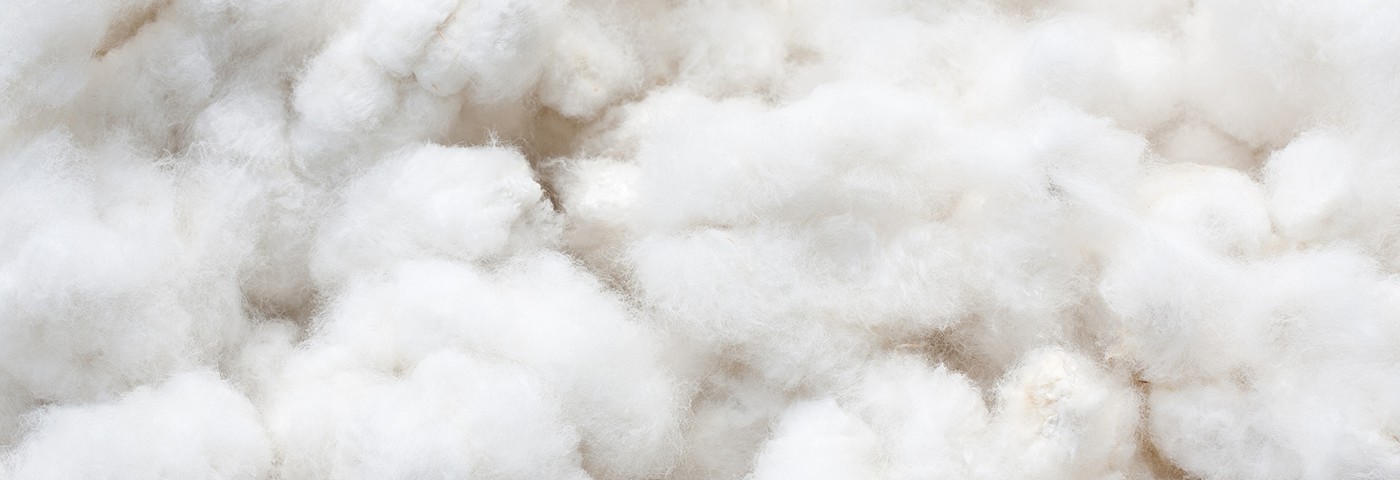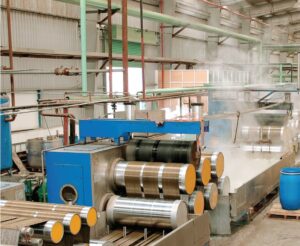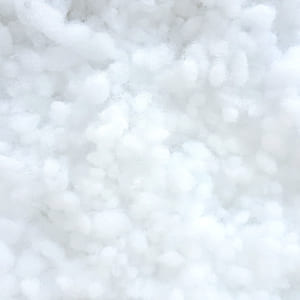What is cotton?
Cotton is one of the most widely used and most favoured materials for fashion. It has been cultivated and refined by man for more than 5000 years, but today cultivation methods have become an environmental problem. As designers, we need to know what consequences our choice of materials have, and cotton is one to pay extra attention to.
Cotton is the second highest consumed fibre in the world, accounting for 35% of the total fibres utilized, with applications for nearly all types of apparel and selected types of footwear. In addition to its use in 100% cotton textiles, it is also blended in various combinations with polyester, spandex, rayon, and hemp as well as other fibres.
Cotton can be sorted by staple length, character, and grade. Staple length determines the quality and the fineness of the final product, as longer staples produce softer, smoother, stronger fabrics with higher luster. The colour of the fibre ranges between white and yellow, and is also graded on reflectivity.
Cotton is relatively strong, and is 30% stronger when wet. Resiliency in cotton is very low, causing degradation and frequent wrinkling. Cotton may be mercerized to improve absorbency and improve dyeability. Fabrics made entirely from cotton yarn will shrink, especially when treated in hot water.
Cotton that contains remnants of leaves, dirt, and other agricultural byproducts will result in lower quality fabric. Immature and coarse fibres also degrade the character of cotton, reducing fineness and can cause defects in fabrics.
Characteristics of cotton
- Absorbent
- Machine washable
- Resistant to high heat
- No static buildup
- Stronger when wet
- Soft hand feel
Cotton Production
The production of cotton begins with the seed at field, cultivation, and ginning.
Cotton grows well in temperate and hot climates that have sufficiently long growing seasons. Cotton is produced in over 100 countries, while the largest producers are China, India, followed by United States and Pakistan. Cotton fabrics are manufactured globally, with China producing the majority of finished textiles.
Fields are cleared and planted, followed by cultivation of the plants. Time from planting to flowering is about three months with an additional two month maturation period for the cotton boll to be ready for harvest. A boll contains the seeds as well as cotton fibres, called lint.
Once the seed cotton is open to the air, it dries and, in many areas, defoliants are applied to reduce staining of the lint from leaves.
Seed cotton is then packed into modules and sent to cotton gins. Once at gin, the seed cotton is fluffed, foreign matter is removed, and cotton lint is separated from the cottonseed. Lint is then packaged into bales for shipment to textile processors.
Cotton is classed into colour grades based on the purity of the whiteness and the reflectivity of cotton. It is also evaluated based on average fibre strength, length uniformity, and staple length.
China
Chinese farmers primarily grow upland cotton, Gossypium hirsutum, as well as some long-staple cotton, G. barbadense. China is one of the largest producers of cotton, but has no system to officially collect and report market information.
In Xinjiang province, which produces half of the country’s cotton, large, government-owned or operated farms remain key players in the sector. Consequently, farms in this region are typically larger and more mechanized. The majority of Chinese cotton is grown from GMO (genetically modified organisms) seed, with over 65% of Chinese cotton acreage planted with Bt cotton, genetically modified to resist bollworms and other pests.
Typical Chinese cotton yields are high and increasing.
India
Indian farmers are the only growers of all four species of cultivated cotton – Upland cotton (G. hirsutum), long staple cotton (G. barbadense), and two varieties of Asian cotton (G. arboretum and G. herbaceum); 90% of production is hybrid cotton.
Indian cotton is grown primarily by millions of smallholders who typically farm family plots under 1.5 hectares. Indian farmers plant cotton in lower densities to allow weeding with livestock. Farmers in central and southern India grow cotton that allows multiple harvests, or pickings, while northern regions with high levels of irrigation grow traditional short duration cotton that allows a crop rotation between wheat and cotton. The northern region also tends to have larger farms and a more mechanized process.
The majority of Indian cotton is grown from GMO (genetically modified organisms) seed, with 93% of Indian cotton acreage planted with Bt cotton, genetically modified to resist bollworms and other pests.
Typical Indian cotton yields are low, but increasing.
Processing of cotton
Processing of cotton includes processes such as opening, cleaning, mixing, carding or combing, drawing, roving, spinning.
Cotton lint must be cleaned of dirt and plant matter, and must first be opened from the packed bale. This process loosens the fibres and blends fibres from multiple bales. Very short fibres, debris, and other detritus are removed during this stage. After the fibres are prepared, they are carded to align and remove remaining contaminants and turned into slivers. The slivers are then drawn through consecutive rollers that improve the alignment of the fibres. Long-staple fibres undergo a combing process, which removes short fibres and further improves the uniformity of the sliver.
Spinning may be done on rings, open-ended rotors or via a few other methods. Ring-spun cotton is the most common form of transforming parallel fibres into yarn. They are drawn into strands and twisted to improve tensile strength.
Spun yarn can either be woven or knit into a textile.
Woven textiles are produced on looms that combine warp yarns with filling yarns to produce a stable fabric. The type of loom used in the weaving process determines the environmental impacts: water-jet looms have high water usage, though it is reclaimed, but the fabric must be dried before storage, increasing energy consumption. Projectile looms are low energy, accounting for half as much energy as rapier looms, and a third as much as air-jet looms.
Knitting is done by machines that loop yarns together to create a more flexible textile. Knitting requires significantly less energy than weaving, with a 20 fold decrease in energy demand. Vibration, lint, noise and energy are all lower on knitting machines than for weaving looms.
To sum up, cotton is one of the most widely used and most favoured materials for fashion, and when grown conventionally has large environmental impacts in terms of water, land and chemicals usage in the cradle-to-gate stage. However, alternative cultivation and production methods exist, and with attention and care it is possible to source cotton that is much better for the environment.
Energy
The energy it takes to produce one kg of cotton fibre depends on the country, but as an average of Chinese, U.S. and Indian cotton production, 15 MJ of energy is required.
Cotton from cradle-to-gate (up to undyed woven fabric) requires various energies depending on the fineness of the yarn. Basically, the finer the yarn, the more energy it requires (between 450 MJ/kg for 70 dtex yarn to 150 MJ/ kg for 300 dtex yarn).
Soil and land
Cotton can be grown in many soils, but deep medium to heavy soils are best, and soil should retain water well.
While intensification of cotton crops has resulted in decreased land-use intensity, decades of intensive farming and the use of chemical fertilizers and pesticides have taken their toll on soils. To just maintain the same yields, farmers are using larger amounts of chemical fertilizers. In India, it is estimated that one-third of the country’s irrigated land is affected by salinity or is expected to become affected in the near future, which has a detrimental effect on plant growth and yield.
Also, plastic film that is often used to decrease weed growth is then plowed under, which can leave residues in the soil.
About 3% of the global agricultural acreage is dedicated to cotton cultivation. Globally, an estimated 4-5% of arable land has been abandoned due to intense cotton cultivation (data from 2006).
Water
Most of China’s cotton is grown in what China Water Risk (CWR) defines as the ‘Dry 11’ and ‘Deficit 6’ provinces. While Xinjiang is a relatively water appropriate cotton growing region, Hebei and Shandong are water scarce regions for cotton.
Crop water productivity (CWP) for Chinese cotton ranges from 0.15-0.37 kg/m3. Cotton has one of the lowest CWPs of any agricultural crop (the higher the value, the more efficient the water use). Much of Chinese cotton is rain-fed, although in some areas, particularly Xinjiang, irrigation is increasingly common due to low water availability throughout most of the year. The average virtual water content of Chinese conventional cotton is of 2,018 m3/ton lint. Virtual water content is defined as the volume of water used to produce a commodity incorporating precipitation as well as irrigation water (the lower the number, the better). Supplemental irrigation is used on an estimated 25-40% of crops during the cultivation cycle when rain is inadequate. In the drier northwest regions, 60% of production is reported to be irrigated (unofficial estimates go as high as 100%).
India is among the more water-challenged nations with farms, industry, and urban populations all competing for limited water resources. Over half of India is subject to high to extremely high water stress. Much of India’s cotton growing regions coincide with the high and extremely high water stress areas.
Crop water productivity (CWP) for Indian cotton ranges from 0.27-1.31 kg/m3. Indian cotton is produced under high evaporative water demand conditions (800-1,000 mm) and largely rain-fed averaging only 400 mm, thus resulting in poor crop yields, and a very high virtual water content (rainfall and irrigation) of 8,662 m3/ton seed cotton.
Water use is very limited in the later stages of the cradle-to-gate life cycle. Water may be used to humidify mills and in water-jet looms. (Water use in the consumer use-phase is a whole other issue, but not accounted for here.)
Chemicals and hazardous waste
Conventional cotton production typically requires intensive use of agricultural chemical inputs. About 16% of global insecticide and 7% of pesticide consumption are attributable to cotton crops. Chemical use includes fungicides for seeds, pre-emergent herbicides, post-emergent herbicides, insecticides and related pest control chemicals, growth regulators, and defoliants. Areas may be sprayed aerially, by tractor or by hand from a backpack.
A large variety of chemicals are used in both China and India. Insect and weed adaptation has been occurring at increasing rates, which tends to result in heavier use of pesticides.
Most Chinese and Indian farms depend on laborers who apply treatments by hand, often from backpack sprayers and with little protection. While some studies have found that the use of Bt cotton has reduced pest problems, there is growing evidence that secondary pests are countering the perceived benefits of Bt cotton in terms of pesticide reduction. Chinese farmers continue to apply higher quantities of pesticides than in other cotton growing countries. The World Health Organization (WHO) has noted nearly 40% of the active ingredients used in China are pesticides classified as extremely or highly hazardous. Chinese farmers also report frequent pesticide poisoning, with 27% reporting experiencing effects.
Residual agricultural chemicals may end up as hazardous waste.
Co-products And By-Products
Seed cotton is the only economically important product from cotton harvesting. Secondary co-products of ginning include cottonseed used for oil, animal feed, cosmetics, and fertilizer.
Solid Waste
At every stage, from harvest to fibre to fabric, there is a loss of material that does not have any economic value. Major cotton wastes include cotton stalks, gin waste, and fabric selvage associated with textile weaving or knitting. Other solid wastes are associated with chemical use (containers) and packaging of cotton as it moves through the life cycle via transportation.
Wastewater
Depending on the watering system, cotton growing can result in large volumes of wastewater runoff (as much as 50% of applied water). Runoff typically contains fertilizers and pesticides.
Greenhouse Gas Emissions
Key sources of GHG emissions are fuel use for farm equipment, electricity use primarily for pumping water, and nitrous oxide emissions associated nitrogen-based fertilizers.
Electricity use in ginning, spinning and weaving will result in relatively higher GHG emissions due to the extensive use of coal for power generation in China.
IMPACTS
Score In MSI
To examine the difference in impact of Organic or Recycled cotton compared to conventional cotton, you can try swapping the raw material inputs and certifications in the Higg MSI. It is clearly evident, that choosing organic or recycled cotton reduces the score significantly, meaning that it is much better for the environment.
Remember that the Higg MSI is a cradle-to-gate material scoring tool, which addresses impacts that range from the extraction or production of raw materials, through manufacture and finishing, to when the material that is ready to be assembled into a final product.
Conventional Cotton
GOTS Certified Cotton
GRS Certified Recycled Cotton
OTHER CONCERNS
Potential Social and Ethical Concerns
Social and ethical concerns for cotton grown and processed conventionally include potential harmful exposures to hazardous chemicals used in farming. Human exposures may occur to on-site workers as well as surrounding communities due to pesticide drift and through pesticide and fertilizer contaminated water; similarly ecosystem exposures to flora and fauna occur on and off the farm and have contributed to hypoxia of surface waters and marine environments.
Extensive exposure to cotton fibers in the processing can lead to health issues.
The intensity of water use may compete with food crops in water scarce areas.
Employment in cotton cultivation can be marginal, with many workers working for low wages or in-kind, with limited access to labour protections or worker’s rights. Child labour can also be an issue.
Availability Of Material
In the 2017 Pulse of the Fashion Industry Report, Global Fashion Agenda and Boston Consulting group anticipate that the volume of water consumed by the fashion industry will increase by 50% by 2030, which is critical, because some of the main cotton-producing countries such as China and India are located in areas that are already suffering from high or medium to high levels of water stress. Those levels are projected to become even more severe, as the shortfall between demand and supply of water is projected to reach 40% by 2030. Thus, as water scarcity becomes more extreme, cotton-growing nations and the fashion industry may face the dilemma of choosing between cotton production and securing clean drinking water.
While cotton prices have been projected to remain relatively stable at a projected real annual growth of 1%, that figure could increase given increasing water scarcity worldwide and how it might affect the cost of future cotton production.
Availability Of Certified Material
Cotton sustainability standards and initiatives exist, including organic and Better Cotton Initiative (BCI) cotton.
Certified organic cotton is produced in accord with geographic specific agricultural standards, integrating ecological processes, maintaining local biodiversity, and avoiding the use of toxic and persistent synthetic pesticides and fertilizers as well as genetically modified seeds. Independent certification agencies accredited by organizations that maintain strict controls over certifiers are responsible for certifying organic cotton according to country specific standards. To maintain certification, the organic cotton must be kept separate from noncertified cotton and be traceable from the farm to the finished product.
BCI is a nonprofit organization that seeks to improve environmental, economic, and social impacts of cotton cultivation. Initiated by apparel companies and NGOs to support a large scale transition away from conventional cotton growing practices, BCI is an intermediate standard that helps reduce pesticides, increase yields and economic opportunity, and improve water utilization. These benefits are achieved through farmer training and capacity building throughout the production chain.
BCI standards ban the use of certain high hazard pesticides identified in Annex A and B of the Stockholm Convention; BCI also intends to phase out hazardous chemicals identified by WHO as class 1a and 1b and the Rotterdam Convention.
E.g. according to numbers from 2013, Chinese and Indian BCI farmers used 10% and 22% less pesticide on their crops than Comparison Farmers, as measured by the quantity of active ingredients applied. In terms of fertilizers, Chinese BCI farmers were measured to use 1% less synthetic fertilizers, and 42% more organic fertilizers, while Indian BCI farmers used 28% less synthetic fertilizers and 22% more organic fertilizers than the Comparison Farmers.
Source from Design for Longevity
Read more: https://vnpolyfiber.com/what-is-cotton/





